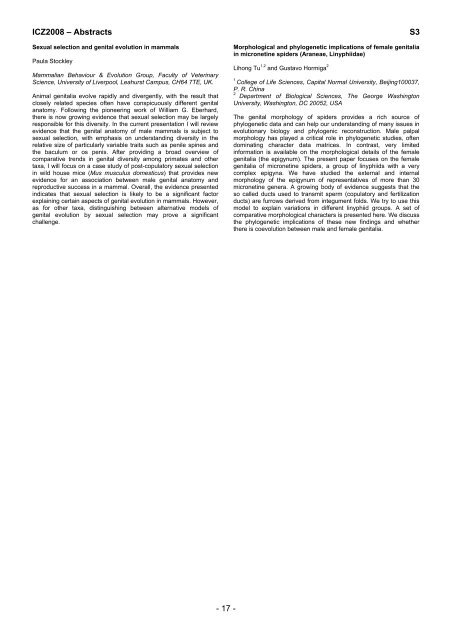CONTENT - International Society of Zoological Sciences
CONTENT - International Society of Zoological Sciences
CONTENT - International Society of Zoological Sciences
Create successful ePaper yourself
Turn your PDF publications into a flip-book with our unique Google optimized e-Paper software.
ICZ2008 – Abstracts S3<br />
Sexual selection and genital evolution in mammals<br />
Paula Stockley<br />
Mammalian Behaviour & Evolution Group, Faculty <strong>of</strong> Veterinary<br />
Science, University <strong>of</strong> Liverpool, Leahurst Campus, CH64 7TE, UK.<br />
Animal genitalia evolve rapidly and divergently, with the result that<br />
closely related species <strong>of</strong>ten have conspicuously different genital<br />
anatomy. Following the pioneering work <strong>of</strong> William G. Eberhard,<br />
there is now growing evidence that sexual selection may be largely<br />
responsible for this diversity. In the current presentation I will review<br />
evidence that the genital anatomy <strong>of</strong> male mammals is subject to<br />
sexual selection, with emphasis on understanding diversity in the<br />
relative size <strong>of</strong> particularly variable traits such as penile spines and<br />
the baculum or os penis. After providing a broad overview <strong>of</strong><br />
comparative trends in genital diversity among primates and other<br />
taxa, I will focus on a case study <strong>of</strong> post-copulatory sexual selection<br />
in wild house mice (Mus musculus domesticus) that provides new<br />
evidence for an association between male genital anatomy and<br />
reproductive success in a mammal. Overall, the evidence presented<br />
indicates that sexual selection is likely to be a significant factor<br />
explaining certain aspects <strong>of</strong> genital evolution in mammals. However,<br />
as for other taxa, distinguishing between alternative models <strong>of</strong><br />
genital evolution by sexual selection may prove a significant<br />
challenge.<br />
- 17 -<br />
Morphological and phylogenetic implications <strong>of</strong> female genitalia<br />
in micronetine spiders (Araneae, Linyphiidae)<br />
Lihong Tu 1,2 and Gustavo Hormiga 2<br />
1<br />
College <strong>of</strong> Life <strong>Sciences</strong>, Capital Normal University, Beijing100037,<br />
P. R. China<br />
2<br />
Department <strong>of</strong> Biological <strong>Sciences</strong>, The George Washington<br />
University, Washington, DC 20052, USA<br />
The genital morphology <strong>of</strong> spiders provides a rich source <strong>of</strong><br />
phylogenetic data and can help our understanding <strong>of</strong> many issues in<br />
evolutionary biology and phylogenic reconstruction. Male palpal<br />
morphology has played a critical role in phylogenetic studies, <strong>of</strong>ten<br />
dominating character data matrices. In contrast, very limited<br />
information is available on the morphological details <strong>of</strong> the female<br />
genitalia (the epigynum). The present paper focuses on the female<br />
genitalia <strong>of</strong> micronetine spiders, a group <strong>of</strong> linyphiids with a very<br />
complex epigyna. We have studied the external and internal<br />
morphology <strong>of</strong> the epigynum <strong>of</strong> representatives <strong>of</strong> more than 30<br />
micronetine genera. A growing body <strong>of</strong> evidence suggests that the<br />
so called ducts used to transmit sperm (copulatory and fertilization<br />
ducts) are furrows derived from integument folds. We try to use this<br />
model to explain variations in different linyphiid groups. A set <strong>of</strong><br />
comparative morphological characters is presented here. We discuss<br />
the phylogenetic implications <strong>of</strong> these new findings and whether<br />
there is coevolution between male and female genitalia.


